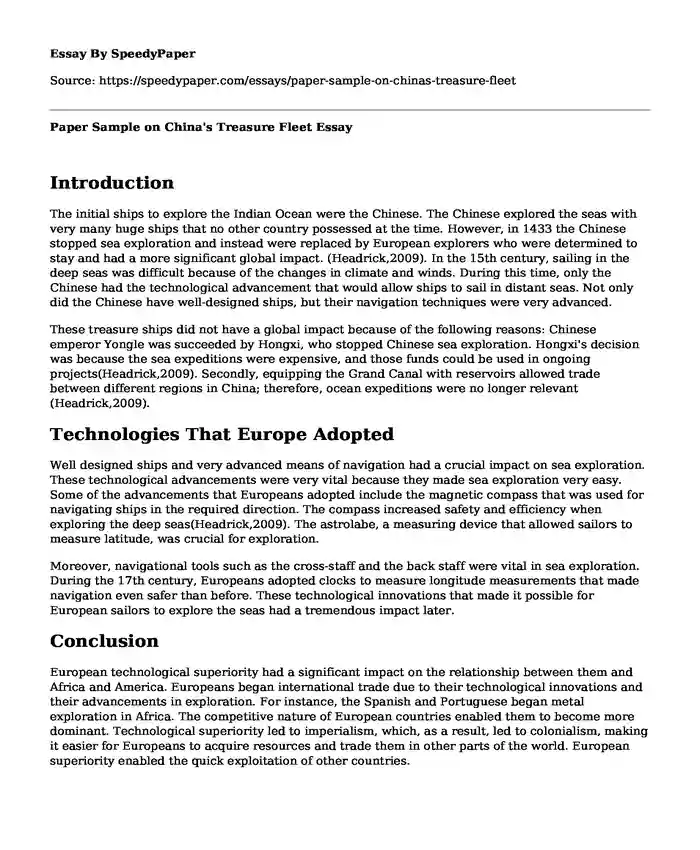Introduction
The initial ships to explore the Indian Ocean were the Chinese. The Chinese explored the seas with very many huge ships that no other country possessed at the time. However, in 1433 the Chinese stopped sea exploration and instead were replaced by European explorers who were determined to stay and had a more significant global impact. (Headrick,2009). In the 15th century, sailing in the deep seas was difficult because of the changes in climate and winds. During this time, only the Chinese had the technological advancement that would allow ships to sail in distant seas. Not only did the Chinese have well-designed ships, but their navigation techniques were very advanced.
These treasure ships did not have a global impact because of the following reasons: Chinese emperor Yongle was succeeded by Hongxi, who stopped Chinese sea exploration. Hongxi's decision was because the sea expeditions were expensive, and those funds could be used in ongoing projects(Headrick,2009). Secondly, equipping the Grand Canal with reservoirs allowed trade between different regions in China; therefore, ocean expeditions were no longer relevant (Headrick,2009).
Technologies That Europe Adopted
Well designed ships and very advanced means of navigation had a crucial impact on sea exploration. These technological advancements were very vital because they made sea exploration very easy. Some of the advancements that Europeans adopted include the magnetic compass that was used for navigating ships in the required direction. The compass increased safety and efficiency when exploring the deep seas(Headrick,2009). The astrolabe, a measuring device that allowed sailors to measure latitude, was crucial for exploration.
Moreover, navigational tools such as the cross-staff and the back staff were vital in sea exploration. During the 17th century, Europeans adopted clocks to measure longitude measurements that made navigation even safer than before. These technological innovations that made it possible for European sailors to explore the seas had a tremendous impact later.
Conclusion
European technological superiority had a significant impact on the relationship between them and Africa and America. Europeans began international trade due to their technological innovations and their advancements in exploration. For instance, the Spanish and Portuguese began metal exploration in Africa. The competitive nature of European countries enabled them to become more dominant. Technological superiority led to imperialism, which, as a result, led to colonialism, making it easier for Europeans to acquire resources and trade them in other parts of the world. European superiority enabled the quick exploitation of other countries.
References
Headrick, D. R. (2009). Technology: A world history. An Age of Global Interactions.Oxford University Press.
Cite this page
Paper Sample on China's Treasure Fleet. (2023, Dec 12). Retrieved from https://speedypaper.com/essays/paper-sample-on-chinas-treasure-fleet
Request Removal
If you are the original author of this essay and no longer wish to have it published on the SpeedyPaper website, please click below to request its removal:
- Animal-Assisted Therapy in Wounded Warrior - Essay Example
- The Death Penalty Debate, Free Essay from Our Database
- Essay Example Describing the First Experience: The Maldives Visiting
- Essay Sample on Social Justice Movement in American History
- Essay Sample on The Rise of Newark
- Possibility of Eliminating Prisons - Free Paper Sample
- Feudalism: Medieval Government & Military Exchange Service - Essay Sample
Popular categories





